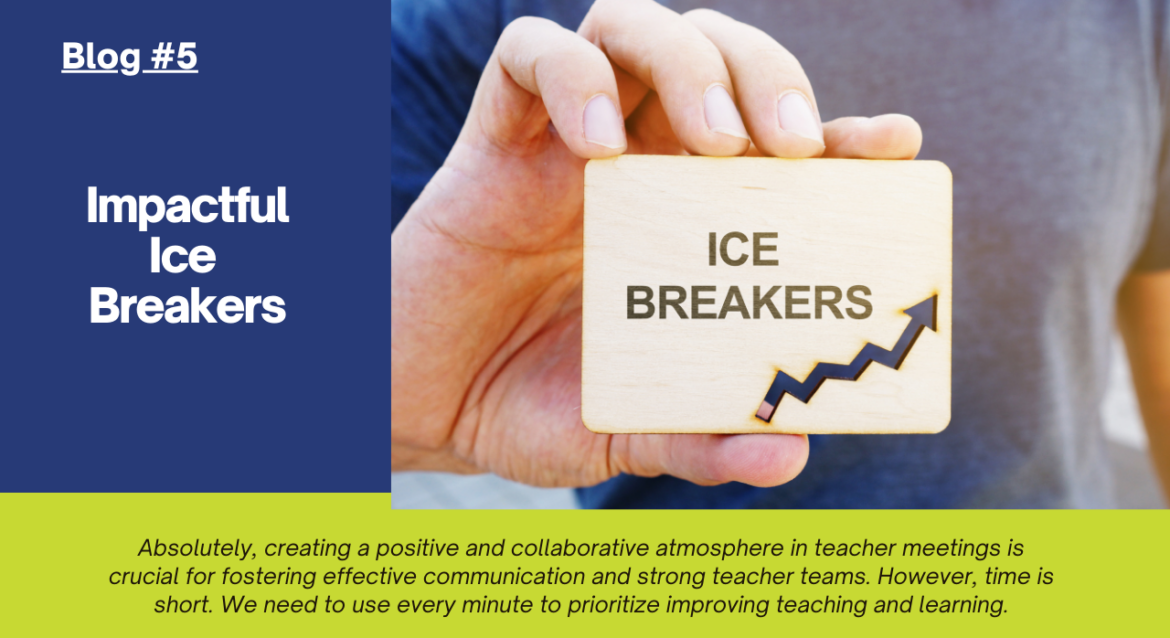
Absolutely, creating a positive and collaborative atmosphere in teacher meetings is crucial for fostering effective communication and strong teacher teams. However, time is short. We need to use every minute to prioritize improving teaching and learning. So, here are some categories of ice breakers that foster connection AND keep the team focused on the critical work of impacting students.
1. Curricular Resource Connections:
- Share your favorite curricular resource that you’ve used to teach a concept. Explain why you chose it. Explain the impact on students.
- Discuss a memorable activity or resource that engaged your students in a particular lesson. Explain the impact on students.
2. Assessment and Data-Based Decision-Making Connections:
Share a strategy you’ve used to make formative assessments more interactive for students. How do you know when students are getting it and when they are not? What did you do? What was the impact?
- Share how you modify assessments to accommodate students that need it. What was the impact? What went well? What, if anything would you change?
- Describe a situation where data guided you to differentiate or scaffold instruction effectively. How do you know it was effective? What was the evidence?
3. Scaffolding Whole Group Core Instruction Connections:
- Share a method you’ve employed to scaffold instruction for a diverse group of learners in a whole-class setting. What was the scaffold? What were the outcomes? Did you continue to use it? Why?
- Explain how you scaffold your lessons to ensure all students can access core content and achieve the learning objectives (essential questions, learning targets, success criteria).
4. Small Group Targeted Instruction:
- Share an activity that worked well with a small group of struggling learners to improve their achievement of the learning objectives (essential questions, learning targets, success criteria).
- Discuss a successful strategy for helping a small group of students grasp a complex concept. What was the strategy? What was the outcome you were looking for?
5. Interventions and Enrichment:
- Talk about an intervention that effectively supported a student’s social-emotional and/or academic growth. What was the intervention? How long did you use it? What data did you gather to determine it was effective?
- Share an example of an enrichment activity that sparked curiosity and passion in your students and moved them along the teaching and learning progression (restate knowledge, gain knowledge, apply knowledge, extend knowledge).
6. Strong Teacher Teams:
- Share a situation where collaboration among teachers led to success for students. What was the collaboration? How did you define success for students? What did you learn?
- Discuss how cross-curricular collaboration improved student outcomes through shared strategies. Who did you collaborate with? What was the ultimate goal? How did you measuring meeting the goal?
Remember, the key to successful ice breakers is to ensure they’re inclusive, non-threatening, and promote a sense of belonging. Encourage teachers to share personal anecdotes and experiences related to the topics discussed. This will not only help build stronger teacher relationships but also contribute to a culture of professional growth and learning and stronger impact on students.
We must take care of the teachers, leaders, and coaches that take care of our children.
-Debbie
Our aim is simple: to provide as many helpful resources as possible to teachers, leaders, and coaches. Every comment you make and every share helps us achieve this goal.
Leave a Comment: Your thoughts and experiences are valuable to us and other readers. Join the conversation and help us all learn more!
Share with Others: Know other teachers who could benefit from our resources? Spread the word and help us reach more educators


